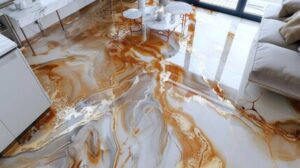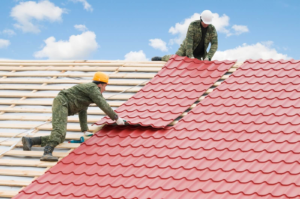Epoxy offers a durable and polished look for your garage floor, providing a safe, chemical-resistant surface. It’s also easy to clean and is stain-resistant, so spills aren’t a problem.

Proper concrete surface preparation is essential to ensuring a strong epoxy bond with the underlying concrete. This involves thoroughly cleaning and repairing cracks. Contact Garage Epoxy Flooring Taylor for professional help.
The durability and cost-efficiency of epoxy floors make them a great choice for homeowners who want a sleek, modern look for their garage. They can withstand heavy equipment and furniture, resist temperature changes, and reduce the amount of dust that settles on other parts of your home. However, it’s important to keep in mind that epoxy floors do require some care and maintenance.
For example, epoxy can crack or chip if it’s exposed to high levels of heat. It’s also a good idea to place protective pads under heavy machinery or furniture. Additionally, it’s important to clean your floor regularly. Oil, gasoline, bleach, and other chemical spills can damage your floor, but an epoxy coating is resistant to most of these substances. If you notice any scratches or stains, it’s best to repair them immediately.
Epoxy floor coatings are highly customizable, allowing homeowners to create an aesthetic that reflects their personal style or business identity. For instance, metallic epoxy floors use a unique blend of pigments to create a shimmering effect that can mimic the look of marble or molten metal. They can also be designed to showcase a brand’s logo or incorporate other decorative flakes for a one-of-a-kind look.
In addition to a variety of color combinations, epoxy can be customized with textures and patterns that add visual interest to a room. For example, a checkerboard pattern is popular in many garages, but you can choose any design that suits your space. In fact, epoxy can be customized with a range of geometric shapes and fractal patterns that create a truly unique floor.
Another way to customize your epoxy floor is by adding anti-slip granules. These add a level of texture to the surface, increasing grip and safety. They can also be custom-colored to match your floor. Additionally, epoxy floors can be printed with graphics and logos to support hygiene protocols in commercial spaces or reinforce branding for residential settings. Epoxy flooring is a great way to transform any space and add value to your property. However, it’s important to consult a professional installation company to ensure that your new floors are safe and durable.
Durability
When it comes to flooring, the ability to withstand heavy traffic and impact is a must. Epoxy is a durable material that can hold up to the wear and tear of busy residential garages and commercial spaces. It’s also resistant to stains and scratches, making it a smart choice for any space that requires a level of durability not found in traditional flooring materials.
There are several factors that affect the durability of epoxy floors, including color, type of coating, and how it is applied. While DIY epoxy floor installation is possible, many homeowners lack the necessary expertise or time to complete the project correctly. This can result in subpar application and a less-than-stellar finish, shortening the lifespan of the floor. Choosing a professional installer like Mid America Service Solutions can eliminate these challenges and ensure that your new floor is beautiful, durable, and long-lasting.
Epoxy can be applied in a variety of colors to complement your home’s decor or match your favorite team’s color scheme. It can even be coated with flakes or glitter to add texture and visual interest. However, the color of your epoxy floor will eventually fade over time due to constant exposure to sunlight. To combat this, a polyaspartic top coat can be applied to your epoxy floors to increase their UV resistance.
The tensile strength of your epoxy is another factor that determines its durability. This metric measures how much pulling force the epoxy can endure before it cracks. Ideally, you want to choose an epoxy solution with high tensile strength to avoid failure under stress. A good way to test this is by dropping a steel ball onto the floor from various heights. The lower the indentation left by the ball, the more tensile strength the floor has.
Whether your floors are exposed to chemicals or other toxic substances, an epoxy coating will protect them. While other types of floors may break down after repeated exposure to corrosive materials, an epoxy floor will retain its integrity and continue to look great. This means that you won’t have to worry about the expensive repairs and replacements that other materials require.
Low Maintenance
While epoxy flooring is durable, it requires regular maintenance to prevent damage and extend its lifespan. This is especially important in high traffic areas, where dirt and grit may scratch or dent the surface. Regularly sweeping or vacuuming the floor to remove dust and crumbs will keep it looking good and free of dirt and grime. Using mats in areas where heavy equipment or vehicles are frequently parked can help to distribute weight and reduce stress on the floor. Using furniture pads, sliders or dollies when moving heavy items will also reduce the likelihood of scratches and other damage. Additionally, reducing UV exposure can protect the floor from discoloration and other deterioration over time.
Epoxy floors are highly resistant to a variety of chemicals, including gasoline, bleach, cleansers and transmission fluid, making them ideal for garages and industrial settings. They are also abrasion-resistant and can withstand heavy shock or impact. This makes them one of the most resilient flooring options for any application. Cleaning the floor is simple and can be done with a mild detergent or acid-neutral cleaner – avoid abrasive or corrosive chemicals that may damage the surface.
An epoxy floor coating can be made into a non-slip surface by adding aggregate in the topcoat or mixing in a slightly textured grit to the base coat. This is particularly important for garages that see a lot of vehicle or foot traffic and can help prevent accidents.
Lastly, epoxy floor coatings reflect light to brighten dark garages and workspaces. This is a great safety measure that can help keep the space well-lit and easy to navigate.
Before a new coating can be applied, the existing concrete surface must be cleaned thoroughly and cracks filled (if any). Grinding the surface and removing any oil or grease will also help to ensure better adhesion. Once the slab is prepared, primer will be applied to the entire surface to seal and prepare it for the new epoxy coating.
Once the primer has dried, it’s time to apply the actual epoxy coating. The process will begin with the preparation of the substrate by troweling and squeegeeing to create an even texture. Then, the epoxy resin will be mixed according to instructions and carefully applied to the substrate. After a few hours, a hardening agent is added to the mixture and allowed to cure for up to three days.
Safety
From heavy equipment to parked vehicles, the garage is home to numerous items that can pose safety risks if not properly handled. Fortunately, epoxy floor coatings are designed with safety in mind. They’re highly resilient and extremely durable, making them tough against chemicals, spills, impacts, and heavy foot traffic. As a result, they protect the concrete slab beneath them from damage and provide a smooth surface that’s easy to clean.
When combined with other design features, like anti-slip additives, epoxy flooring makes for a safe and attractive workspace that supports hygiene protocols and complies with all applicable regulations. Additionally, it’s low-VOC and non-toxic, which makes it a great choice for businesses that place a high value on sustainability.
Unlike other types of floors, epoxy is resistant to moisture and won’t warp or crack with exposure to water. This feature helps it stand up to the elements and reduces the need for regular repairs and replacements, saving you time and money.
As an added bonus, epoxy floors are also durable against impact and abrasions. They’re hard to scratch, dent, or damage, and it takes a pretty serious blow to do any significant harm. That’s why they’re a popular choice for warehouses and industrial settings where frequent drops, scrapes, and other damage is a reality.
Epoxy floors are also a smart investment for business owners because they protect against costly damage to the concrete slab underneath them. This prevents moisture from damaging the foundation, allowing it to remain strong and stable for years to come.
Although epoxy is resistant to most chemicals, some are still able to damage its surface over time. To extend the life of your epoxy, make sure to avoid harsh cleaners and use a soft-bristled broom or vacuum to sweep and mop the floor. You should also schedule regular inspections to look for any areas that need repair or resealing.
One of the most powerful long-term benefits of epoxy is how easy it is to maintain. Its durable surface resists wear and tear and can endure heavy foot and equipment traffic for a long time. The smooth, glossy topcoat is easy to clean and sanitize with warm water and mild detergents, and this allows you to reroute the resources you would have spent on frequent repairs to more valuable projects.





